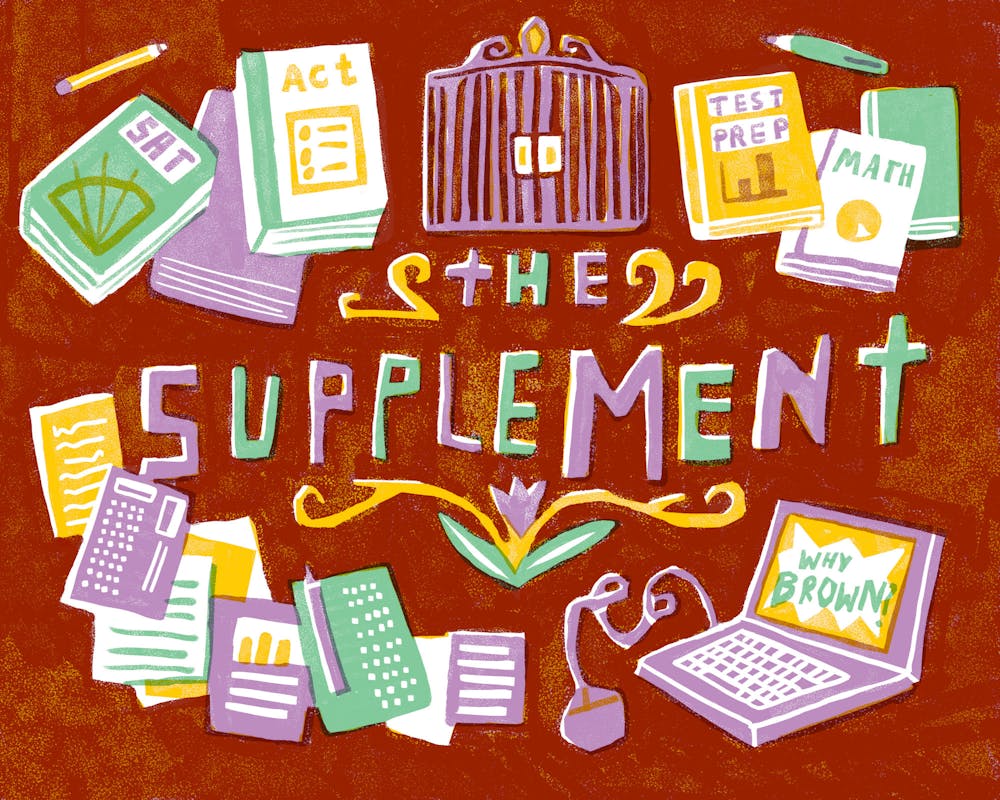The Supplement is a new series and newsletter by The Brown Daily Herald aimed at providing applicants to the University, and their families, with perspectives from students and admission officers on the application process, as well as other admission news. To receive The Supplement in your inbox for the rest of the semester, you can sign up below.
Asya Gipson ’25, frozen in time on YouTube as a high school senior, stares straight into the camera.
“Are you looking for passionate, interesting students to attend your school?” she asks. “Well, look no further! Because I have three charming applicants just for you.” On the screen rolls a bouquet of roses and a graphic in the style of ABC’s ‘The Bachelor,’ reading “The Applicant.”
Gipson’s video, in which she introduces three different prospective applicants with different interests, concludes with a gimmick: The three applicants are actually all her.
Every Ivy League institution other than Brown recommends that prospective applicants complete a virtual alumni interview as part of their application — though Cornell only requires one for specific schools within the university. But for the classes of 2024 and 2025, the University, citing concerns about access to stable internet connections for a 45-minute interview, legal guidelines about interacting with minors online and a host of other issues, shifted to recommending applicants submit a two-minute video introduction, an option they first introduced for the class of 2023.
The video introduction is a smaller part of the application, which also includes a number of essays, a transcript and teacher recommendations, among other elements. Five first-years interviewed by The Herald detailed their different approaches to the creative process — ranging from intensive productions to not submitting the video at all.
According to admission officers and resources the University provides, the videos are not judged on production value or videography. Instead, the Admission Office focuses on the “content and information,” said admission officer Bailey DiOrio.
DiOrio added that she often advises applicants not to worry about “technical pieces.”
A quick YouTube search returns dozens of students like Gipson who, after sending their video introductions to the University privately, put theirs online to serve as inspiration for next year’s applicants. Students often refer to these videos as “video portfolios.”
Some are as simple as students talking to their laptop camera; others are as elaborate as Gipson’s, and a fair number that make it to YouTube have a musical component.
“It can be as simple as they want,” DiOrio said. “Some of the best video introductions are students sitting in front of their laptop or shooting on their phone, selfie style.”
James Walsh, another admission officer, stressed that applicants should focus on their “paper” applications first — the elements like essays and recommendations. And he noted that the deadline for video introductions is a few days later than the deadline for the rest of the application.
Students, Walsh noted, might want to consider touching on pieces of themselves that they hadn’t mentioned elsewhere in their application, or expanding further on something they briefly discussed.
“It shouldn’t be you rehashing your resumé,” he added. Common topics include hometown tours, discussions about favorite books, research that students are interested in or their families.
Keelin Gaughan ’25, a first-year from outside of Dallas, Texas, recorded a relatively simple video, which was the last piece of her application. After days of brainstorming, she landed on framing a broader narrative about art and storytelling using her favorite book, “Station Eleven” by Emily St. John Mandel. Writing a script and recording it in front of a camera took a day, and the editing took another, she said.
“I’m not super talented at editing,” Gaughan said. “I know people who could do super amazing, talented things that I couldn’t compare with. I knew it would be a better approach for me to talk to the camera.”
Gipson — the mock Bachelor contestant hailing from Anchorage, Alaska — said that she brainstormed for a week before writing a script over the course of a day, filming on her iPhone the next day with help from her mom, and editing in HitFilm, a free video-editing software, on another day.
Elijah Cohen ’25’s video, a Ferris Bueller-esque look at his “quarantine routine” that alluded to him “going insane,” included him engaging in a staring contest with his dog and attempting to blow the shell off a hard-boiled egg. But it also featured a dive into the art he creates and an interaction with a purple, human-like animated character edited into his video. The idea, he said, was to combine art, animation and humor.
While learning to use a green screen took some time, Cohen, who hails from Los Angeles, California, estimated that the video came together over the span of three days, with some filming help from his dad. He animated in Procreate, a popular drawing app, and edited his video in iMovie.
“I was having so much fun with it,” he said. “It wasn’t like, ‘I have to get it done.’”
The person who watches the video, Walsh noted, is often looking to see if the applicant presented in a file matches the person on video. The memorable ones, he said, feel authentic.
“That always stands out to me,” he said, “when you have that feeling of, ‘this is exactly who that student is, and they’re showing me their true self.’”
“Something that was important to me in doing the video was being very earnest about who I was,” Gaughan said.
Gipson said that she hoped her willingness to break out of the traditional dialogue with the camera would show off her creativity.
“I feel like a part of what made it fun is that it was corny,” she said. Her mom was initially skeptical but came around to the idea as the video came together.
“My video is pretty ridiculous,” Cohen said. “If they didn’t like it, then Brown was not right for me.”
Most videos will only be watched by one or two people, DiOrio said. During a case summary at committee meetings where the University decides if it will admit a student, an admission officer might summarize an applicant’s video if it’s “particularly strong” or gives insight into something that makes an applicant “tick.”
Some applicants also choose not to submit videos at all, DiOrio noted.
Mikael Obiomah ’25, from Taunton, Massachusetts, said he chose not to submit a video. “My essays did more than a video ever would have,” he said.
TyKerius Monford ’25, from Athens, Georgia, added that he felt “overwhelmed” by the process and thought he had shown every aspect of himself through the University’s specific supplements and those required for the QuestBridge program.
“I was a little nervous,” Monford said. “But I was like, ‘It will work itself out if it’s meant to be.’”
“It’s absolutely okay if the student doesn’t feel like they have the time to put together the video, or if that might not be the best way for them to express themselves,” DiOrio said, adding that leaving out a video will not hurt an applicant’s chances. Still, she noted that the University “strongly recommends” submitting videos because they find them to be “incredibly helpful.”
Some students post their videos online in an effort to help future applicants. Though most students don’t see viral success, some applicant’s videos get thousands of views, such as Cohen, whose video had racked up 185,000 views as of Nov. 15.
“I’ve had a decent amount of people come up to me and say, ‘you’re the guy from the video portfolio!’” he said. “I’ve never experienced something like that before.” One first-year, he said, approached him, took a selfie and sent it to her mom — who also knew who Cohen was.
Cohen said he has never posted anything else to YouTube. And while the video serves as a good conversation starter, he admitted he doesn’t like when other people pull it up in front of him: he’s seen it too many times.
Gipson, whose video has more than 15,000 views, said she’s been recognized once or twice. When she posted it, she said she had no expectation of it leading to interactions at the University.
“When I first met my roommate, I was talking about, ‘I submitted a video portfolio,’” Gipson said. “She was like, ‘I know, I watched it.’”

Will Kubzansky was the 133rd editor-in-chief and president of the Brown Daily Herald. Previously, he served as a University News editor overseeing the admission & financial aid and staff & student labor beats. In his free time, he plays the guitar and soccer — both poorly.





